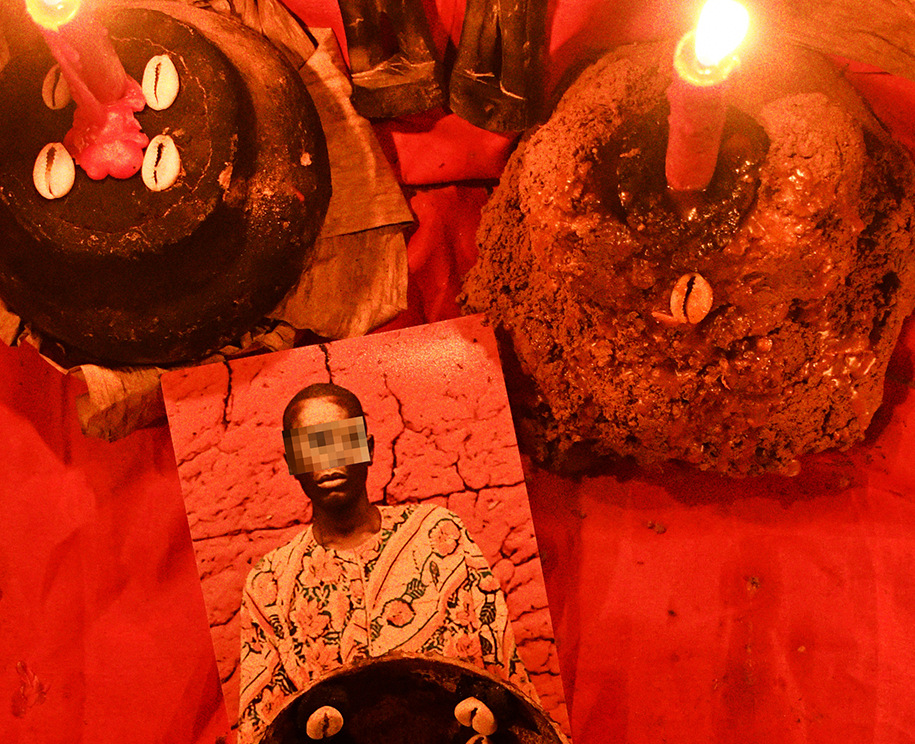Adeyemi Akande
Dimensionality and Replacement: Photographs as Surrogates in West African Cultures and Religion.
In several traditional societies of tropical Africa, sculpture serves as a medium: communicating and transmitting energies between mortal and spiritual dimensions. It features prominently in almost every sphere of the social, cultural, religious, and even political essence of the African continent, and it is the central platform through which traditional societies encode and uphold certain belief systems. In the late 19th century, photography arrived on the continent. Quite instantly, it presented an alternative form of image production in the region, offsetting sculpture as the primary medium for constructing and propagating both spiritual and physical identity.

Wasiu Olawale, Photo print used as a medium of trans-spatial communication, Altar of Awosé, Ibadan, 2021
Indigenous rationalization during the 19th century struggled with the idea of naturalistic visual imagery, outside the known systems which were wholly dependent on religious structures. While the production of images in much of early West Africa was seen as a deeply spiritual act and, as such, linked to the religious framework of the local society, photographic imaging was independent. Not only did it become acceptable within traditional religious practice, but it also became the prime material medium for a trans-spatial transfer of energy.
My study investigates the use of photographs as a material replacement for sculpture in the spirituality of traditional West African societies. It affirms the notion of the metaphysicality of photographs and how this new conceptualization of the medium fit into the worldview of traditional religion and rituals in West Africa.
On a technical front, the camera offered unmatched realism, which captured the attention of local societies. However, my research reveals that the value of factual resemblance is not its prime attribute; rather, it is photography’s ability to present key features that define the “spiritual identity” of the individual. These key features are believed to be best articulated on the face, which is the zone through which any active interaction and/or communication with one’s spirit is actualized. Consequently, the face is the platform through which the act of spiritual duplication can be achieved.
Within West African traditional religion, one sees that frontality (or a frontal orientation) is valuable. This notion, and by extension the importance of the face and presumably the eyes, as the portal through which access is granted into an individual’s spiritual essence, is popular. In the 2013 work “A Photograph Steals the Soul,” Z. S. Strother alluded to this phenomenon of the face as a portal. Examples of this idea can be found among the Akan, Baule, Idoma, Fon, Senufo, Igbo, and Yoruba, who reserve the most important communications and interactions for face-to-face contact. Early Yoruba kings covered their faces in public with beaded fringes—not only to protect people from the potency of the king’s face (or eyes), but also to protect the king from evil attacks.
Further, my study finds that the use of photographic prints in traditional West African religion extends only as far as representation and replacement of mortals and physical objects. Assemblages and stylized sculpture remain the primary element for the representation of deities. As far as the deities are concerned, visual oratory has and perhaps must remain symbolic. The factual identity of deities must remain a matter of speculation and something that is constantly examined, but really never seen.
On Evidence and Secrecy
Because of the sacred and secretive nature of many rituals, it becomes challenging to confirm claims of supernatural manipulations of images in a manner that alters reality. This challenge opens yet another world of secrecy and underscores the lack of obligation that traditional priests have to show evidence of anything they claim. Kwame Anthony Appiah posits that there is immense power that comes from the knowledge of elders who understand how to communicate with ancestors, and this power is one of the first and most obvious sources of secrecy in Africa. While some scholars have argued that secrecy is a commodity among African religious structures, in his study of Dangme art and the politics of secrecy, Nii Quarcoopome has stated that power is not revealed in how it is expressed, but rather in how it is concealed.
University of Lagos
Leonard A. Lauder Visiting Senior Fellow, June–August 2023
Following his residency, Adeyemi joined the School of Arts, Architecture and Design at London Metropolitan University as a senior researcher.
